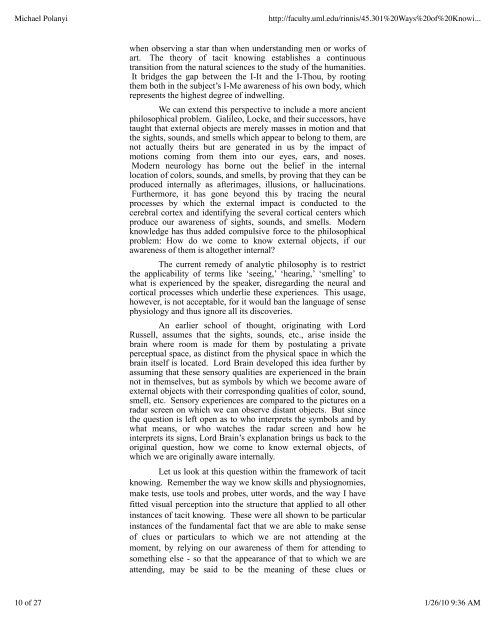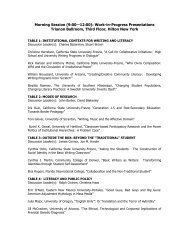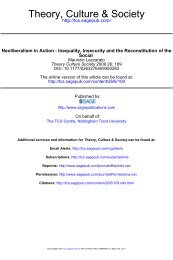Tacit Knowing: Its Bearing on Some Problems of Philosophy
Tacit Knowing: Its Bearing on Some Problems of Philosophy
Tacit Knowing: Its Bearing on Some Problems of Philosophy
Create successful ePaper yourself
Turn your PDF publications into a flip-book with our unique Google optimized e-Paper software.
Michael Polanyi http://faculty.uml.edu/rinnis/45.301%20Ways%20<strong>of</strong>%20Knowi...<br />
when observing a star than when understanding men or works <strong>of</strong><br />
art. The theory <strong>of</strong> tacit knowing establishes a c<strong>on</strong>tinuous<br />
transiti<strong>on</strong> from the natural sciences to the study <strong>of</strong> the humanities.<br />
It bridges the gap between the I-It and the I-Thou, by rooting<br />
them both in the subject’s I-Me awareness <strong>of</strong> his own body, which<br />
represents the highest degree <strong>of</strong> indwelling.<br />
We can extend this perspective to include a more ancient<br />
philosophical problem. Galileo, Locke, and their successors, have<br />
taught that external objects are merely masses in moti<strong>on</strong> and that<br />
the sights, sounds, and smells which appear to bel<strong>on</strong>g to them, are<br />
not actually theirs but are generated in us by the impact <strong>of</strong><br />
moti<strong>on</strong>s coming from them into our eyes, ears, and noses.<br />
Modern neurology has borne out the belief in the internal<br />
locati<strong>on</strong> <strong>of</strong> colors, sounds, and smells, by proving that they can be<br />
produced internally as afterimages, illusi<strong>on</strong>s, or hallucinati<strong>on</strong>s.<br />
Furthermore, it has g<strong>on</strong>e bey<strong>on</strong>d this by tracing the neural<br />
processes by which the external impact is c<strong>on</strong>ducted to the<br />
cerebral cortex and identifying the several cortical centers which<br />
produce our awareness <strong>of</strong> sights, sounds, and smells. Modern<br />
knowledge has thus added compulsive force to the philosophical<br />
problem: How do we come to know external objects, if our<br />
awareness <strong>of</strong> them is altogether internal?<br />
The current remedy <strong>of</strong> analytic philosophy is to restrict<br />
the applicability <strong>of</strong> terms like ‘seeing,’ ‘hearing,’ ‘smelling’ to<br />
what is experienced by the speaker, disregarding the neural and<br />
cortical processes which underlie these experiences. This usage,<br />
however, is not acceptable, for it would ban the language <strong>of</strong> sense<br />
physiology and thus ignore all its discoveries.<br />
An earlier school <strong>of</strong> thought, originating with Lord<br />
Russell, assumes that the sights, sounds, etc., arise inside the<br />
brain where room is made for them by postulating a private<br />
perceptual space, as distinct from the physical space in which the<br />
brain itself is located. Lord Brain developed this idea further by<br />
assuming that these sensory qualities are experienced in the brain<br />
not in themselves, but as symbols by which we become aware <strong>of</strong><br />
external objects with their corresp<strong>on</strong>ding qualities <strong>of</strong> color, sound,<br />
smell, etc. Sensory experiences are compared to the pictures <strong>on</strong> a<br />
radar screen <strong>on</strong> which we can observe distant objects. But since<br />
the questi<strong>on</strong> is left open as to who interprets the symbols and by<br />
what means, or who watches the radar screen and how he<br />
interprets its signs, Lord Brain’s explanati<strong>on</strong> brings us back to the<br />
original questi<strong>on</strong>, how we come to know external objects, <strong>of</strong><br />
which we are originally aware internally.<br />
Let us look at this questi<strong>on</strong> within the framework <strong>of</strong> tacit<br />
knowing. Remember the way we know skills and physiognomies,<br />
make tests, use tools and probes, utter words, and the way I have<br />
fitted visual percepti<strong>on</strong> into the structure that applied to all other<br />
instances <strong>of</strong> tacit knowing. These were all shown to be particular<br />
instances <strong>of</strong> the fundamental fact that we are able to make sense<br />
<strong>of</strong> clues or particulars to which we are not attending at the<br />
moment, by relying <strong>on</strong> our awareness <strong>of</strong> them for attending to<br />
something else - so that the appearance <strong>of</strong> that to which we are<br />
attending, may be said to be the meaning <strong>of</strong> these clues or<br />
10 <strong>of</strong> 27 1/26/10 9:36 AM





